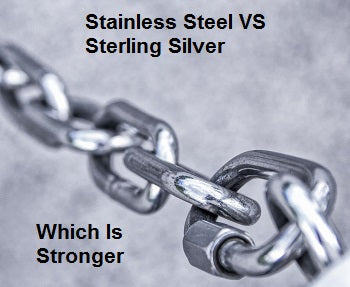
When you buy jewelry, you want to invest your money in a piece that will last a lifetime if properly taken care of.
Choosing jewelry made of a strong material will ensure that your ring, necklace, etc. will endure years of wear. This choice is especially important if you work with your hands or don’t have the time to take special care of delicate metals.
Today, we will be comparing two popular metals used in jewelry – stainless steel and sterling silver – in order to determine which is ultimately the better option for wearers who need something extra durable.
Is stainless steel stronger than sterling silver?
Stainless steel is harder than sterling silver and this in turns means that overall stainless steel is stronger than sterling silver is.
Stainless Steel
Stainless steel has become a more popular metal over the years to be used in jewelry, especially in rings. It combines many of the best properties of other metals on the market and results in jewelry that is easy to care for and highly durable.
Basic Properties of Stainless Steel
There are several types of jewelry-grade stainless steel, but they all share the same basic properties that contribute to the product’s overall strength.
- Durability
Stainless steel is highly durable, meaning that it won’t warp under pressure or break as easily as other metals do. On the Mohs Scale of Hardness, this metal rates between a 5-6, making it more durable than iron, platinum, and gold among others.
- Resistance to Corrosion
One thing that makes stainless steel jewelry stronger overall than those made of other metals is its resistance to corrosion. Harsh chemicals and even plain water may corrode some metals over time, eating away at the shiny exterior and weakening it if not regularly cleaned and cared for.
This metal’s anti-corrosion properties help to make it last longer and stay stronger.
Pros and Cons of Stainless SteelWhile stainless steel has many strengths, it is not immune to weaknesses that may make the jewelry less desirable, depending on the wearer’s needs. Strength isn’t solely about durability and hardness or even corrosion resistance, so it’s essential to compare its strengths and weaknesses together.
Pros
- Stainless steel is an inherently strong metal. It resists bending, warping, scratching, denting, and snapping quite well. This makes it ideal for the person who does manual labor or the person who needs jewelry that can be worn in everyday life.
- The corrosion resistance of stainless steel allows it to last longer if properly taken care of. The metal stays strong, handling moisture, chemicals, and other corrosive substances well.
- Jewelry made of this material is easy to clean and care for. It doesn’t tarnish easily, so constant polishing is not necessary. The physical beauty of stainless steel stays more apparent with less effort.
Cons
- Stainless steel is more brittle than other metals, including sterling silver. While it is still fairly ductile, it’s not impossible to snap into pieces and the strength combined with brittleness make rings made of this material more difficult to resize.
- Because stainless steel is harder to reshape, you have less options when it comes to finding jewelry that you like made of the metal. It can’t be molded into as many different shapes.
- There are downsides that come with such strong jewelry, meaning that it will be more difficult to remove in emergency situations. If you work with dangerous equipment or try to wear the jewelry when you have outgrown it, you have a higher chance of injuring yourself with stainless steel jewelry.
Sterling Silver
Sterling silver has consistently been a favorite among jewelry wearers for centuries. This metal is elegant, shiny, and easy to shape into rings, bracelets, necklace chains and charms, etc. As is true of any other metal, it has its own strengths and weaknesses.
Basic Properties of Sterling Silver
Sterling silver has many desirable properties, but some can be considered drawbacks in terms of strength and overall durability. Both the benefits and detriments are significant and may greatly impact your decision to buy the jewelry.
- Durability
Sterling silver is far more durable than its pure silver counterpart. This is because it is actually an alloy of silver, nickel, and other trace metals. The trace metals increase its strength and durability against direct pressure or heat. On the Mohs Scale of Hardness, sterling silver rates a 2.5. It’s as strong as 24k yellow gold.
- Ductility
Jewelry made of sterling silver is fortunately not brittle, making up for its low overall strength and durability. This means that the metal can warp, but can also be fixed as it doesn’t snap and break easily. It can also be resized.
Pros and Cons of Sterling SilverSterling silver is, in some respects, weaker than many other metals, including stainless steel. However, this metal has its strengths that keep jewelry wearers everywhere coming back for more.
Pros
- Sterling silver is easily molded and shaped into several styles of jewelry, and it’s easier to resize. It’s versatility will work to your benefit if you often outgrow your jewelry. Stainless steel rings may last longer, but they may not be consistently wearable over the course of your life.
- This metal can also stand the test of time as long as you care for it properly. It is not as durable as other metals, but it is strong enough to keep for decades regardless. Its natural properties will work in your favor to change with your lifestyle and wearing habits.
- Sterling silver is very beautiful and lustrous. This fact gives it an edge over the competition in marketable strength. Some prefer beauty over durability because jewelry is meant to be eye catching and ornamental.
Cons
- This silver alloy is not very durable in the traditional sense. It is easily scratched, dented, and warped. The metal does not endure pressure for very long, and most everyday objects can scratch the surface. It is also not corrosion resistant, meaning that you must be careful not to expose your jewelry to the elements if it can be avoided.
- Sterling silver is harder to clean and care for. If you want your jewelry to last for a long time, you have to clean, polish, and care for it regularly. Caring for stainless steel is easy, but keeping sterling silver in optimal shape takes more time and money than some are willing to spend.
- This metal is easy to tarnish. Sterling silver dulls and turns green if not polished and cleaned often enough. This greatly detracts from its beauty, making it weaker in the department of looks over time.
Stainless Steel v. Sterling Silver: A Comparison of Strengths
Measuring which metal of these two is ultimately stronger comes down to how well they fare in three categories: hardness, durability/ductility, and resistance to corrosion.
- Hardness
The hardness of a metal generally determines how well it endures or resists scratching, denting, and warping. The metal that is the hardest is also typically the strongest, unless it is especially brittle.
On the Mohs Scale of Hardness, stainless steel beats sterling silver by several points. The silver alloy is as easy to damage as gold, the softest jewelry material of them all.
- Durability/Ductility
In terms of durability and ductility, stainless steel and sterling silver draw even.
Steel is more durable than sterling silver, resisting high pressure and scratching. The metal is much more difficult to break or otherwise irreparably damage.
However, sterling silver is more ductile. Because it bends more easily, it may last a person longer through multiple resizings and repairs.
- Corrosion Resistance
Stainless steel’s main appeal is its resistance to corrosion and tarnishing. The elements and certain harsh chemicals (i.e. household cleaners, chlorine) won’t cause it to break down quickly and ruin. Sterling silver, on the other hand, is easy to corrode and tarnish. Unless it is taken care of properly, sterling silver jewelry can’t endure regular wear through the years.
Stainless Steel: The Ultimate Winner
When you consider the three categories that make a metal “strong” in the eyes of jewelers and jewelry wearers, stainless steel is a clear winner against sterling silver. It is the perfect metal for manual laborers, low-maintenance people, and those who would like to wear their jewelry for all occasions.
However, the definition of strength is subjective. Some may still prefer sterling silver if they don’t wear jewelry very often or are meticulous in jewelry maintenance.
Those who work in an office can expect their sterling silver jewelry to last quite a while just fine, as these pieces won’t have to withstand much pressure or potential warping/denting everyday.
In summary, the strongest metal objectively is stainless steel. Subjectively, the decision hinges entirely on the needs and desires of the wearer.
No matter which metal you prefer or need to fit your lifestyle, there is a perfect piece out there waiting to beautifully decorate the finger, neck, or arm of yourself or someone you love. You can find a wide selection of beautiful and affordable stainless steel and sterling silver jewelry at Think Engraved.
More Articles You Will Love
What Is The Best Wedding Ring For A Man?

